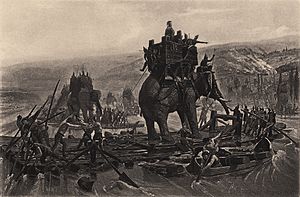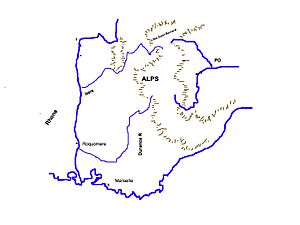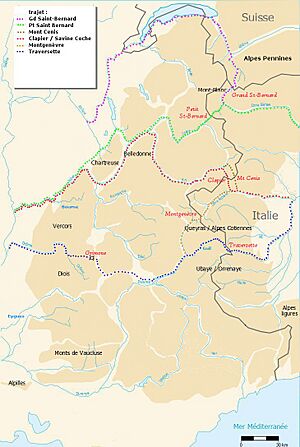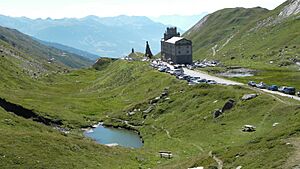Hannibal's crossing of the Alps facts for kids
Quick facts for kids Hannibal's crossing of the Alps |
|||||||
|---|---|---|---|---|---|---|---|
| Part of the Second Punic War | |||||||
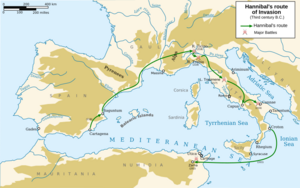 Hannibal's route to Italy |
|||||||
|
|||||||
| Belligerents | |||||||
| Commanders and leaders | |||||||
| Hannibal Hasdrubal Mago Hasdrubal Gisco Syphax Hanno Hasdrubal the Bald Hampsicora Maharbal |
Publius Cornelius Scipio Tiberius S. Longus |
||||||
| Strength | |||||||
| 94,000+ (Polybius) 36,000 (Delbrück) |
Unknown | ||||||
| Casualties and losses | |||||||
| 68,000+ (Polybius) 2,000 (Delbrück) |
Unknown | ||||||
Hannibal's crossing of the Alps in 218 BC was a huge event in the Second Punic War. It is one of the most famous achievements in all of ancient warfare.
Hannibal led his Carthaginian army over the mighty Alps mountains. He marched them into Italy to fight the Roman Republic directly. This move helped him avoid Roman armies and their strong navy.
Most of what we know comes from two ancient writers. They are Polybius and Livy. They wrote about these events many years after they happened. The Alps were not well mapped back then. So, figuring out Hannibal's exact path is still a mystery for historians.
Contents
Why Hannibal Crossed the Alps
After losing the First Punic War, Carthage was defeated by Rome. Hamilcar Barca, a brave Carthaginian general, wanted to make up for these losses. Carthage had lost land like Sicily and Sardinia to the Romans.
The Romans made Carthage pay a lot of money and took away their navy. But Carthage was a rich trading city. They could still pay the tribute. Hamilcar and his family, the Barcas, wanted to conquer Iberia (modern Spain). This land had many natural resources. It would help Carthage get strong again.
Hamilcar planned to use Iberia as a base. From there, he wanted to start a new war against Rome. He began conquering Iberia in 238 BC. He took control of the southeastern part of the peninsula.
Hannibal Takes Command
In 228 BC, Hamilcar was killed in battle. His son-in-law, Hasdrubal the Fair, took over the army. Hasdrubal made a treaty with Rome. It said that the Ebro river would be the limit of Carthaginian power in Spain.
Then, in 221 BC, Hasdrubal was also killed. The army chose Hamilcar's 26-year-old son, Hannibal, as their new leader. Hannibal wanted to finish his father's plan. He aimed to conquer all of Iberia and then attack Rome in Italy.
Hannibal spent two years securing Carthaginian lands in Iberia. He put down revolts and conquered new tribes. He brought all of Iberia south of the Ebro under Carthaginian control. Only the city of Saguntum, which was allied with Rome, remained free.
Rome's Situation
Hannibal knew a lot about Roman politics. He thought it was a good time to attack. He even had spies among the Gauls in Roman lands.
Since the First Punic War, Rome had been taking more land in Italy. They also strengthened their control over Sicily, Corsica, and Sardinia.
Rome had also been fighting the Gauls in northern Italy for a long time. The Boii and Insubres tribes had fought Rome. Rome wanted to push its borders all the way to the Alps. By 222 BC, Rome had largely defeated these Gallic tribes. But the Gauls were unhappy and ready to revolt.
Hannibal's Preparations

Hannibal knew the Gauls were upset with Rome. He sent messengers to the Gallic tribes in the Po Valley (northern Italy). He offered them money, food, and guides.
His main goal was to find a safe way to enter the Po Valley after crossing the Alps. Hannibal knew the Alps would be a very tough march. He wanted to avoid fighting a battle right after his army was tired from the mountains.
He also knew that the descent from the Alps was steeper than the climb. This made having allies waiting for him even more important. The Gauls, especially the Insubres and Boii, were eager to help Hannibal. They hated how Rome had treated them.
The Siege of Saguntum
With his plans ready, Hannibal wanted to start the war. He needed to make Saguntum attack him first. This way, Rome would have to declare war. But the Saguntines only complained to Rome.
Rome sent a group to Iberia to try and solve the problem peacefully. Hannibal openly ignored them. He hoped this would make Rome declare war. The Romans realized war was coming soon. They quickly dealt with a small revolt in Illyria. They also built new forts in northern Italy.
Hannibal then sent news to Carthage. He claimed the Saguntines were attacking a friendly tribe. Without waiting for orders, he began to besiege Saguntum. Some in Carthage wanted to hand Hannibal over to Rome. But most people supported the war.
The siege lasted eight months. Rome did not send any help to Saguntum. They were busy with the Illyrian revolt. They did not take Hannibal's threat seriously enough.
After Saguntum fell, Hannibal sold everyone as slaves. He gave the money to his soldiers. He also sent the city's treasures back to Carthage. This helped gain public support for his cause. The rest of the treasure went into his war fund.
March Through the Pyrenees

Hannibal spent the winter in Cartagena after the siege of Saguntum. He let his soldiers go home to rest. He wanted them to be in good spirits for the hard journey ahead. He left his brother Hasdrubal in charge of Carthaginian Iberia.
Hannibal also swapped soldiers from Iberia and Africa. This was to make sure they stayed loyal and did not desert. He also left ships for his brother.
Hannibal knew he had to secure Catalonia. This area had Roman allies. He did not want Rome to have a place to land troops behind him. He planned to get more soldiers from Iberia later. So, he needed to control this region.
He divided his army into three groups. This allowed him to conquer the region quickly. Hannibal set out with 90,000 foot soldiers and 12,000 cavalry. He lost many men fighting the tribes between the Ebro river and the Pyrenees mountains.
After conquering this area, he left his general Hanno in charge. Hanno had 10,000 foot soldiers and 1,000 cavalry. Hannibal also sent another 10,000 foot soldiers and 1,000 cavalry home. He wanted them to speak well of him. He also wanted other Iberians to believe his mission would succeed. This would encourage them to join him later. His remaining army had 50,000 foot soldiers and 9,000 cavalry.
The main group, led by Hannibal, carried the treasure and supplies. It marched along the coast. The other two groups marched through valleys. They subdued any tribes that resisted. All groups were able to support each other if needed. This campaign took two months and cost Hannibal 13,000 men.
March to the Rhône River
After crossing the Pyrenees, the march to the Rhône River was mostly peaceful. Hannibal had spent July and August fighting tribes in the Pyrenees. The tribes along the way had different feelings about Hannibal. Some were friendly, others were not. But Hannibal was good at talking to them. He used his charm and money to get through their lands without fighting.
Massalia (modern Marseille) was a Greek trading city. It was allied with Rome. Massalia tried to get tribes on the east side of the Rhône to fight Hannibal. These tribes did make Hannibal's river crossing difficult.
Meanwhile, Publius Scipio, a Roman consul, was ordered to stop Hannibal. He had 60 ships. But he was slow. When he reached the Po area, the Gauls there revolted. Rome had been setting up new colonies, which angered the Boii and Insubres.
Instead of sending his army to Spain, Scipio had to send them to the Po Valley. He then had to raise new legions. Raising an army was easy for Rome. Many citizens were trained for military service.
Scipio finally sailed from Ostia. It took him 5 days to reach Massalia. To his surprise, he learned that Hannibal was not in Catalonia. Hannibal was about four days' march north of Massalia, on the other side of the Rhône.
Crossing the Rhône River
Historians agree on where Hannibal crossed the Rhône. It was a well-planned and quick operation.
While Rome was slow, Massalia had stirred up tribes on the eastern bank of the Rhône. Scipio decided to stop Hannibal from crossing the river. He sent 300 horsemen up the river to find Hannibal's exact location. Hannibal also learned that a Roman army (22,000 foot soldiers and 2,000 horsemen) had arrived.
Hannibal used the local Celts' hatred for Rome. He convinced them to help him cross the river. He got many boats and canoes. He also had his men build more boats. This took two days.
A tribe called the Cavares waited on the eastern bank. They had a fortified camp. They planned to attack Hannibal's army as it crossed. Hannibal knew about Alexander the Great's river crossing tactics. He used a similar plan. He sent his lieutenant, Hanno, son of Bomilcar, north. Hanno was to cross the river further upstream. Then, he would march south and attack the Cavares from behind.
Hanno marched about 25 miles (40 km) upstream. He found an island that split the Rhône into two smaller streams. There, he built rafts and boats. Hanno's group crossed the river. They then marched south towards the Cavares' camp.
Hannibal made loud preparations to cross the river. This was to distract the Cavares. He wanted them to focus on his main army. Three days later, Hanno signaled that his force was ready. Hannibal immediately ordered his boats to cross.
The crossing was carefully planned. Heavy horsemen went first in the largest boats. Other boats were rowed in their shelter. Many horses swam alongside the boats. Some horses were put on boats fully saddled. They were ready to fight as soon as they landed. This would protect the infantry as they formed up.
The Cavares saw Hannibal's army crossing. They came out of their camp and prepared to fight. They shouted and cheered, trying to scare the Carthaginians.
As Hannibal's army was in the middle of the river, Hanno's group attacked the Cavares from behind. A small part of Hanno's force set the Cavares' camp on fire. The rest attacked the main Cavares army. Some Cavares ran to defend their camp. Most stayed to fight Hannibal's main army. They were split.
Hannibal, on one of the first boats, landed his men. He led them against the confused Cavares. The Cavares were surrounded. They panicked and ran away from the Carthaginian army.
The actual fight was short. But Hannibal had spent five days planning this risky operation. He made sure everything was ready.
From the Rhône to the Alps
Hannibal needed to reach the Alps quickly. He wanted to cross before winter. He knew if he waited, Rome would raise another army. He heard that a Roman army was camped near the Rhône's mouth. He sent 500 Numidian cavalry to get more information.
This cavalry met 300 Roman horsemen. The Numidians lost 240 men. The Romans lost 140. The Numidians were followed back to Hannibal's camp. The Roman scouts saw that Hannibal had not crossed with all his army. They rushed back to tell their consul. The consul sent his army up the river by boat. But they arrived too late.
The Roman consul decided to return to Italy. He would wait for Hannibal there. But he sent most of his army to Spain under his brother, Gnaeus Cornelius Scipio Calvus. The consul hoped to attack Hannibal's supply lines. Romans were used to fighting head-on. They did not know how to cut off enemy supplies. They also often marched carelessly.
After crossing the Rhône, Hannibal introduced his army to Gallic chiefs from the Po Valley. He wanted to boost his men's confidence. The chiefs promised support from the Gauls who hated Rome. Hannibal then spoke to his officers. His speech greatly encouraged his troops.
Hannibal's infantry started marching the day after the assembly. The supply train followed. Hannibal thought the Romans might attack from the south. So, he ordered his cavalry to protect his southern flank. This would give his army time to form up if attacked. But this attack never happened. Hannibal was in the rearguard with the elephants. He thought the Romans might come from the west. His rearguard was strong enough to fight them off. This attack also did not happen.
Hannibal's army marched towards the Insula. The infantry covered about 12.5 miles (20 km) per day. The cavalry and rearguard moved faster, about 19 miles (30 km) per day. In total, they marched about 75 miles (120 km).
When Hannibal's army reached the Insula, they found a Gallic tribe fighting a civil war. Hannibal chose to support the older leader, Brancus. He formed an alliance with Brancus. From this tribe, he received supplies for his journey. He also got their protection. Thanks to Brancus, Hannibal did not have to fight any tribes until he reached the Alps themselves.
Climbing the Alps
No one is completely sure which path Hannibal took through the Alps. Historians still argue about it. The pass Hannibal used would be the highest point of his journey.
Some possible passes include:
- Little St Bernard Pass
- Col de Clapier
- Col de la Traversette
- Col de Montgenèvre
- The pass near Mont Cenis
Recent studies using soil samples have supported the Col de la Traversette route. They found traces of bacteria from horse and mule digestive systems. These traces were dated to around 218 BC, when Hannibal marched. This suggests a large number of animals and people passed through there. The Col de la Traversette is also the highest and most southerly pass, matching ancient descriptions.
According to one historian, Hannibal marched towards Mt. Du Chat. He found the passes guarded by the Allobroges tribe. Hannibal sent spies. They found that the Allobroges only guarded the pass during the day. At night, they left their positions. Hannibal ordered many campfires to be lit. He wanted the Allobroges to think he was settling down for the night. But once they left, he led his best troops to take control of the pass.
Hannibal hid his slingers and archers on a cliff above the path. This was a great spot to attack enemies marching below. The descent from this pass was very steep. The Carthaginians, especially the baggage animals, struggled. The Allobroges attacked anyway. Many baggage animals fell off the cliffs and died. Hannibal led his elite troops against the barbarians. Most of the barbarians died, fighting with their backs to the cliff. After this, Hannibal's army continued down to the plain.
This plain was mostly unguarded. Hannibal marched his army to modern Chambery. He easily took their city. He seized horses, captives, animals, and grain. There was enough food for three days. This was very helpful since they had lost supplies earlier. Hannibal then ordered the town to be destroyed. This was a warning to other tribes not to oppose him.
He rested his men there. Hannibal spoke to his army. He told them how hard the journey would be. But he also cheered them up.
The Carthaginians continued their march. At modern Albertville, they met the Centrones tribe. The Centrones brought gifts and cattle. They also brought hostages to show their loyalty. Hannibal was suspicious of them, but he hid it. The Centrones guided his army for two days. They marched through a narrow pass, possibly the Little St Bernard Pass. There, the Centrones turned against the Carthaginians.
The Centrones waited until half of Hannibal's army had passed. They wanted to split his forces. But Hannibal had expected this. He had arranged his army with elephants, cavalry, and baggage in front. His heavily armed foot soldiers were in the rear. The Centrones rolled boulders and threw rocks down from the slopes. Many pack animals were killed. Confusion spread among the troops in the pass.
However, Hannibal's rearguard held back. They forced the barbarians to come down and fight. The rearguard held off the attackers. Hannibal and the front half of his army spent the night near a large white rock. This rock offered them protection. By morning, the Centrones were gone.
The army rested for two days. It was late October, and it was snowing. The long march, the fighting, and the loss of animals lowered morale. Hannibal's troops had been marching for over five months. The army had shrunk greatly. Most of Hannibal's soldiers were from Africa and Iberia. They were not used to the cold Alps.
According to Polybius, Hannibal gathered his men. He told them the end of their journey was near. He pointed towards Italy, showing them the Po Valley. He reminded them of the Gallic friendship and aid they had been promised. If he was at Col de la Traversette, the Po Valley would have been visible. If he was at Little St Bernard Pass, it would not have been. After three days of rest, Hannibal ordered the descent from the Alps to begin.
Down to Italy
The snow on the southern side of the Alps melts during the day and refreezes at night. Also, the Italian side of the Alps is much steeper. Many men lost their footing and died.
Early in their descent, the army found a path blocked by a landslide. About 300 yards (274 meters) of the path were broken. Hannibal tried to go around it through deep snow. They made some progress, losing more pack animals. But Hannibal realized this route was impossible for an army. He led his men back to the broken path and set up camp.
Hannibal ordered his men to fix the mule path. They worked in shifts, with Hannibal constantly encouraging them. Both sick and healthy men helped. The next day, the road was good enough for the cavalry and pack animals. Hannibal sent them down to the pastures below the tree line.
However, Hannibal's remaining elephants were starving. They could not use the path yet. Hannibal's Numidian cavalry kept working on the road. It took three more days to fix it for the elephants. Once the elephants crossed, Hannibal rushed ahead to the main army.
It took the army three days to march from this point into the plains near the Po River. Hannibal then focused on helping his troops and horses recover. He ordered his men to camp near modern Ivrea. This marked the end of their difficult journey across the Alps. It was the beginning of their campaign in Italy.
See also
- British Alpine Hannibal Expedition
- Napoleon Crossing the Alps


